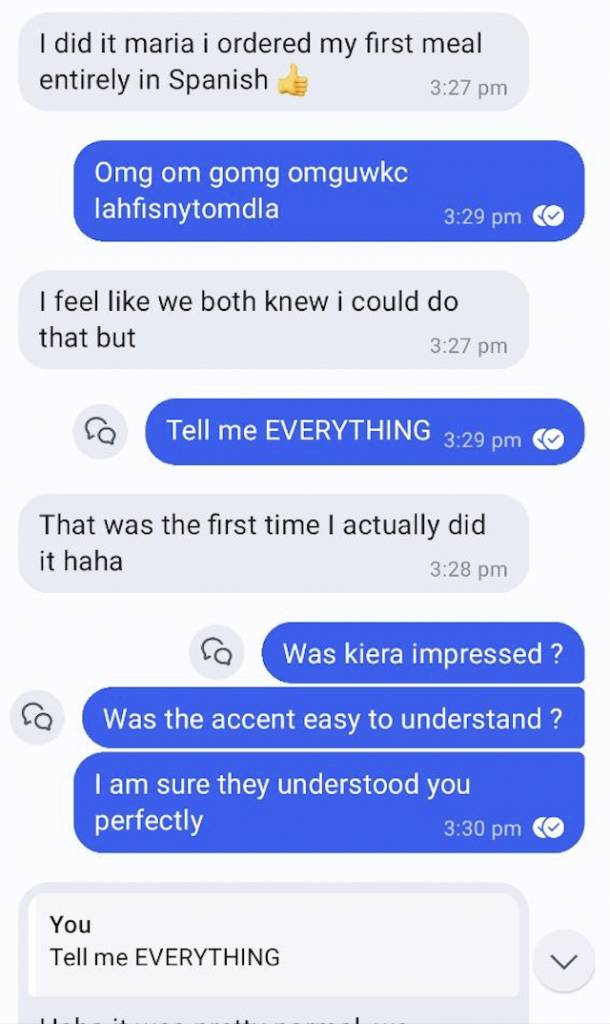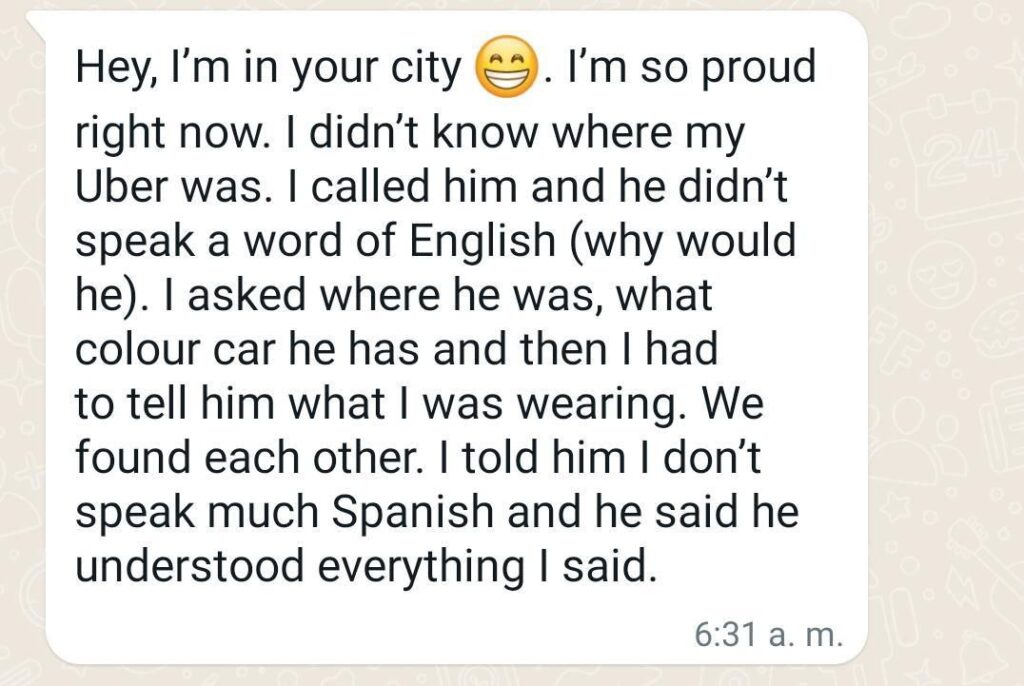You enter a Mexican restaurant and confidently place your order in flawless Spanish. Your family members are surprised, your date is impressed, and the locals can’t believe that you, a foreigner, speak the language so fluently. This is every Spanish language learner’s dream, isn’t it?
Well, I’m here to tell you that it is possible. My name is Maria, and I have been working as a Spanish teacher for quite some time now, specifically for three years. As a teacher, I frequently receive questions from beginners, and the most common ones include:
-
- Maria, is it possible to become proficient in Spanish starting from zero?
-
- How long will it take me to become fluent in Spanish?
-
- How many hours do I need to study to learn Spanish?
Patience, young grasshopper.
In this article, I will guide you through the methods that I believe have helped my most successful students (people who are busy with their everyday lives, living in an English-speaking country) achieve fluency in Spanish without relying on books or tedious grammar exercises. Additionally, you will find a concise guide outlining the steps to follow in order to become bilingual.
During my time as a teacher, I can proudly say that I have witnessed several cases of students successfully achieving fluency in Spanish. My most successful students have been those who demonstrated complete dedication to their language learning journey. In this article, I aim to summarize the common traits shared by my most accomplished students when it comes to mastering Spanish. Additionally, I will provide a step-by-step guide to help you become fluent in Spanish yourself. Furthermore, I will share some resources that I believe will assist you in achieving your Spanish language goals.
What Successful Spanish Students Have in Common:
-
- Fearless Speaking: Fluent Spanish students have the courage to put themselves in situations where they can practice and test their spanish speaking skills. Successful Spanish students are not afraid to make mistakes and actively apply what they have learned. For instance, if you visit a local restaurant that offers its menu in Spanish, such as tacos (typically found in authentic Mexican restaurants), carnitas, fajitas, or Chile con carne, don’t hesitate to try pronouncing the menu items in Spanish. Challenge yourself to engage in a conversation with the waitress or waiter in Spanish.
For example, look at this student who succeeded in achieve his Colombian ID in United States.

Fluent Spanish students are characterized by their curiosity. They possess a genuine interest not only in the grammar of the language but also in the culture, TV shows, and music of Spanish-speaking countries. It’s true that comprehending media or shows in Spanish can be challenging, but the more you consciously enjoy and actively engage with them, the more your subconscious mind absorbs and learns. Through watching this show, he has acquired knowledge that goes beyond what I can teach in a classroom setting. As additional advice, I recommend finding TV shows or YouTubers that you enjoy watching. For example look at this video where I show you how to sound “more colombian”:
So what kind of shows I can watch to learn spanish?
If you like competition shows, you can watch a show called desafio, the equivalent of survivor tv show, looks like this:
Comparisons between the show Survivor and its Latin American equivalent Desafio (colombian tv show)
If you like shows like Dr Phil you can watch Laura en America, looks like this:
If you like shows like Judge judy you can watch Caso cerrado, and it looks like this:
My most successful Spanish students are highly efficient with their time. They not only focus on what they learn during lessons but also make the most of their “off” time by reviewing lessons or engaging in passive learning. For example, some of my students utilize their commuting time, car rides, or sleepless nights to listen to Spanish. If you’re interested, we have created a post specifically addressing this topic. Additionally, at De Una, reviewing lessons is incredibly convenient as we provide a vast library of videos and audios on Spanish lessons. You can rewatch them anytime and anywhere, allowing you to have an additional lesson experience that is included in your subscription.
Now that you have seen from first hand what successful students, have in common, it’s time we customize a plan for you! Here is your
Ultimate guide to learn spanish:
-
- Set Clear Goals: Begin by setting clear and achievable goals for your Spanish language journey. Determine why you want to learn Spanish and what level of proficiency you aim to achieve.
-
- Make a plan: During this part you can use the help of a tutor (In our homepage you can see the ones we have available for you). Set a plan Start with the Basics Begin by mastering the basics of Spanish grammar, vocabulary, and pronunciation. The first topics you might want to familiarize yourself with the alphabet, numbers, greetings, and essential phrases. A solid foundation will serve as a stepping stone for advanced learning.
-
- Immerse Yourself in Spanish: As I said previously, this can vary from putting your phone in spanish to watch tv shows in spanish or listening to spanish music. Surround yourself with authentic Spanish content such as books, newspapers, movies, and music. Listen to Spanish podcasts and radio stations, and consider watching Spanish TV shows or movies with subtitles. This exposure will help you develop an ear for the language and improve your comprehension skills.
One of the things we do in our lessons is using people who speak spanish in American tv shows as study cases. In this video I use 90 days fiancé to teach my spanish students details that you can’t find in a book.
https://www.youtube.com/watch?v=wahZ4D36MFE&t=670s
Practice Speaking: Regular practice is vital for developing fluency in any language. Find language exchange partners or join conversation groups to practice speaking Spanish. Utilize online platforms or language learning apps that provide opportunities to engage in conversation with native speakers. The more you practice speaking, the more comfortable and fluent you will become. Check out this student who practiced his speaking with the uber driver.

Or our teacher speaking with people in Omegle
https://www.youtube.com/shorts/yhm4Anir3xQ
-
- Embrace Language Learning Resources: Take advantage of the wealth of resources available to Spanish learners. Invest in quality videos, audios or books that help you to learn the way you like. You can also ask your teacher of what kind of resources are right for your spanish level.
-
- Expand Your Vocabulary: Building an extensive vocabulary is essential for fluency. Learn new words and phrases every day, and use flashcards or vocabulary apps to reinforce your memory. Keep a vocabulary journal to record new words, their meanings, and example sentences. Engage in reading (or listening) materials suited to your level, and actively incorporate new vocabulary into your conversations.
-
- Grasp Grammar Concepts: While grammar can be challenging, it is crucial for proper communication. Dedicate time to understand the grammatical structures of Spanish, including verb conjugation, noun gender, adjective agreement, and sentence construction. If you are not a huge grammar fan, you can always have the help of a tutor to simplify what books use sometimes chapters to explain (it is possible, I have done it so many times). Practice using these concepts in both written and spoken exercises to reinforce your understanding.
So now you are set up ! Only a few more things: Remember that consistency is Key! Consistent exposure and practice will reinforce your skills and ensure steady progress towards fluency. Also, try to travel ! Traveling to a Spanish-speaking country exposes you to native speakers and provides opportunities to practice in real-life situations.
And remember: being fluent in spanish should be fun! We are here to help you in every step of the way!
See you in class!
Post Views: 320
